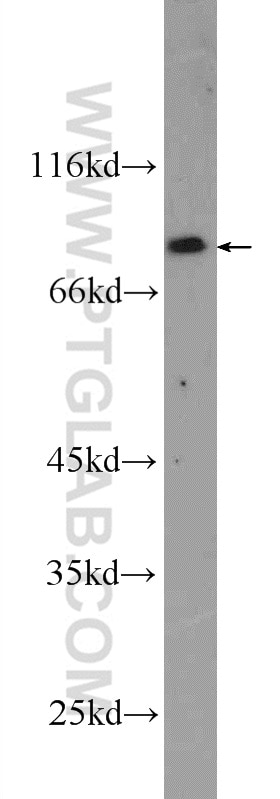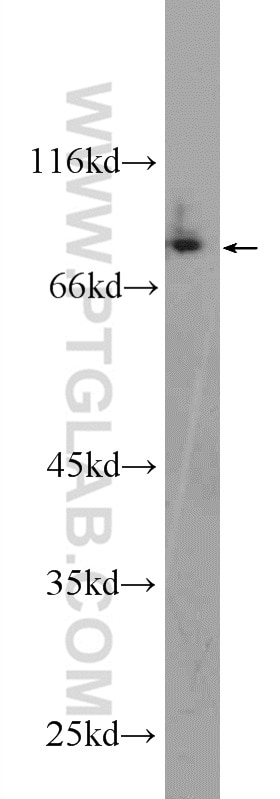CPEB4 Polyklonaler Antikörper
CPEB4 Polyklonal Antikörper für IF, IHC, WB,ELISA
Wirt / Isotyp
Kaninchen / IgG
Getestete Reaktivität
human, Maus, Ratte
Anwendung
WB, RIP, IHC, IF, ELISA
Konjugation
Unkonjugiert
Kat-Nr. : 25342-1-AP
Synonyme
Galerie der Validierungsdaten
Geprüfte Anwendungen
| Erfolgreiche Detektion in WB | SH-SY5Y-Zellen, A375-Zellen, HeLa-Zellen |
| Erfolgreiche Detektion in IHC | humanes Leberkarzinomgewebe Hinweis: Antigendemaskierung mit TE-Puffer pH 9,0 empfohlen. (*) Wahlweise kann die Antigendemaskierung auch mit Citratpuffer pH 6,0 erfolgen. |
| Erfolgreiche Detektion in IF | SH-SY5Y-Zellen |
Empfohlene Verdünnung
| Anwendung | Verdünnung |
|---|---|
| Western Blot (WB) | WB : 1:500-1:1000 |
| Immunhistochemie (IHC) | IHC : 1:50-1:500 |
| Immunfluoreszenz (IF) | IF : 1:50-1:500 |
| It is recommended that this reagent should be titrated in each testing system to obtain optimal results. | |
| Sample-dependent, check data in validation data gallery | |
Veröffentlichte Anwendungen
| WB | See 7 publications below |
| IHC | See 1 publications below |
| RIP | See 1 publications below |
Produktinformation
25342-1-AP bindet in WB, RIP, IHC, IF, ELISA CPEB4 und zeigt Reaktivität mit human, Maus, Ratten
| Getestete Reaktivität | human, Maus, Ratte |
| In Publikationen genannte Reaktivität | human, Maus |
| Wirt / Isotyp | Kaninchen / IgG |
| Klonalität | Polyklonal |
| Typ | Antikörper |
| Immunogen | Peptid |
| Vollständiger Name | cytoplasmic polyadenylation element binding protein 4 |
| Berechnetes Molekulargewicht | 80 kDa |
| Beobachtetes Molekulargewicht | 80 kDa |
| GenBank-Zugangsnummer | NM_030627 |
| Gene symbol | CPEB4 |
| Gene ID (NCBI) | 80315 |
| Konjugation | Unkonjugiert |
| Form | Liquid |
| Reinigungsmethode | Antigen-Affinitätsreinigung |
| Lagerungspuffer | PBS mit 0.02% Natriumazid und 50% Glycerin pH 7.3. |
| Lagerungsbedingungen | Bei -20°C lagern. Nach dem Versand ein Jahr lang stabil Aliquotieren ist bei -20oC Lagerung nicht notwendig. 20ul Größen enthalten 0,1% BSA. |
Hintergrundinformationen
CPEB4 also named as CPE binding protein 4 or hCPEB 4 is a 729 amino acid protein, which contains two RRM domains and belongs to the RRM CPEB family. CPEB4 involves in some forms of synaptic plasticity and regulate translation by binding to regulatory motifs of defined mRNA targets. CPEB1 and CPEB4 are differentially regulated by phase-specific kinases, generating the need of two sequential CPEB activities to sustain cytoplasmic polyadenylation during all the meiotic phases.
Protokolle
| Produktspezifische Protokolle | |
|---|---|
| WB protocol for CPEB4 antibody 25342-1-AP | Protokoll herunterladen |
| IHC protocol for CPEB4 antibody 25342-1-AP | Protokoll herunterladen |
| IF protocol for CPEB4 antibody 25342-1-AP | Protokoll herunterladen |
| Standard-Protokolle | |
|---|---|
| Klicken Sie hier, um unsere Standardprotokolle anzuzeigen |
Publikationen
| Species | Application | Title |
|---|---|---|
Nat Commun Defining the RBPome of primary T helper cells to elucidate higher-order Roquin-mediated mRNA regulation. | ||
Front Cell Dev Biol CPEB4 Inhibit Cell Proliferation via Upregulating p21 mRNA Stability in Renal Cell Carcinoma. | ||
J Transl Med CircESRP1 enhances metastasis and epithelial-mesenchymal transition in endometrial cancer via the miR-874-3p/CPEB4 axis. | ||
Technol Cancer Res Treat miRNA-130a-3p/CPEB4 Axis Modulates Glioblastoma Growth and Progression | ||
Acta Cir Bras Gynura segetum induces hepatic sinusoidal obstruction syndrome in mice by impairing autophagy. | ||
bioRxiv Inhibition of CPEB3 ribozyme elevates CPEB3 protein expression and polyadenylation of its target mRNAs, and enhances object location memory |







